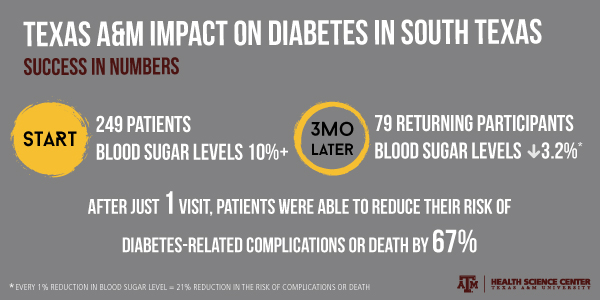Lifesaving lessons: Diabetes self-management education helps save lives in South Texas

Texas is expected to have nearly eight million residents suffering from diabetes by the year 2040, according to a 2010 report released by the Texas Health Institute, State Demographer’s Office and Methodist Healthcare Ministries of South Texas. In South Texas, nearly one in four (20%) adults has been diagnosed with diabetes, according to the Texas Department of State Health Services, but many more have it and don’t know it. And in the Texas Coastal Bend, more than 31% of adults are overweight and 42.3% are obese. That means nearly three quarters of the population in the Coastal Bend is at increased risk for developing type 2 diabetes.
In response to this epidemic, the Texas A&M Health Science Center Coastal Bend Health Education Center (CBHEC) Diabetes Education program provides resources on how to prevent and control diabetes for residents and health professionals of the Coastal Bend – the Southern region of Texas curving around the Gulf of Mexico from the large port cities of Corpus Christi to the southern tip at South Padre.
Diabetes self-management education (DSME) is a critical part of care for those with diabetes and, according to the American Diabetes Association (ADA), is necessary to improve patient outcomes. CBHEC’s Diabetes Education program, which is accredited by the ADA, provides diabetes self-management classes and support to prevent onset of type 2 diabetes and to keep it under control once diagnosed. Classes are offered in English and Spanish in locations throughout the Coastal Bend.
Over the course of four, two-hour classes or a single eight-hour class, certified diabetes educators, registered nurses and a nutritionist teach basic information about diabetes, healthy eating and the importance of physical activity. Participants also receive blood glucose monitors and are taught how to properly test their blood sugar.
Lab work is taken and assessed at the outset of the classes, which includes patients’ height, weight, body mass index, cholesterol, blood pressure, body fat percentage and Hemoglobin A1C. Health professionals use the Hemoglobin A1C test to assess a person’s average blood glucose (blood sugar) levels over the past two to three months. It does this by measuring the percent of hemoglobin (the protein in our red blood cells that carry oxygen) that has glucose attached to it. For people without diabetes, the normal range for the A1C test is between 4% and 5.6%. To control diabetes, the ADA suggests a target level below 7% in those who have already been diagnosed.
“We have one patient that came to class who is losing her eye sight and needs assistance when walking for guidance,” said Delia Martinez, the program’s health coordinator. “She came in with an A1C of 7.3%, which is good, but now it is down to 5% and she has lost 47 pounds.”
A key component to achieving success in a DSME class is the follow-up care. Every three months for one year, CBHEC’s class participants are provided with complimentary follow-up labs and one-on-one consultation. Community health workers are also available to provide additional personal support when needed.
“Follow-ups continue the education patients received in our class,” said David Leal, health educator and nutritionist with the program. “We can answer questions that patients are likely to have after trying to apply the strategies they learned in class.”
To lower A1C levels, Leal recommends patients take their medications as directed and keep their appointments with their health care providers and diabetes education program.
“We empower participants of our program to make change – change that is appropriate in each of their lives and individual situations,” he said.
In addition to DSME, CBHEC’s program offers a variety of diabetes training programs in schools and workplaces throughout South Texas, and specialized training is provided to health care professionals and school faculty to ensure improved quality of care for diabetes patients. In 2013, the program reached a total of 3,227 people.
Because of its impact in the Coastal Bend, the program has plans to expand to a 26-county area of South Texas as part of the Texas A&M Healthy South Texas 2025 Initiative. These extended services will help Texas A&M achieve its goal of reducing preventable diseases, like diabetes, by 25% by the year 2025.
To learn more about the program or to schedule an appointment, please call (361) 857-2945 or visit www.cbhec.tamhsc.edu/de.
Media contact: media@tamu.edu

